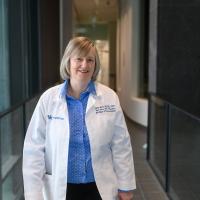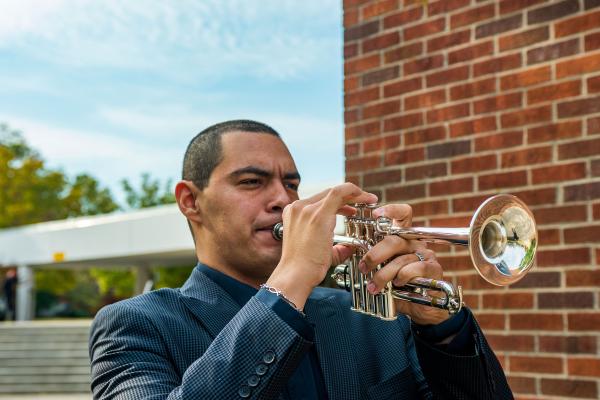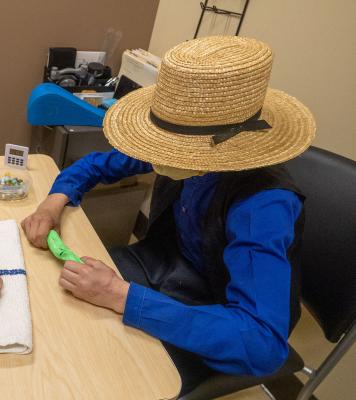




Living Her Dream
In 2019, Alayna Benningfield was living her dream.
At 24, she was living in Hilton Head, South Carolina, working at a beachfront hotel. She spent her downtime swimming in the ocean and hanging out on the sand with her husband, Josh. Life was perfect.
Until she got sick.
She starting vomiting once a week, and the incidents increased in frequency until it became a daily occurrence for hours at a time.
Around Labor Day, the couple left Hilton Head during a hurricane, returning home to Elizabethtown, Kentucky. That’s when the mysterious illness hit its peak and Benningfield was admitted to Baptist Health Hardin.
Doctors suspected she had possibly been exposed to some kind of virus. By the time she was admitted, all traces of a virus were gone, but not before causing severe damage to her heart. Benningfield was referred to UK HealthCare’s Gill Heart & Vascular Institute, where she was initially told her only hope was a heart transplant.
Heart transplants can be difficult for someone as young as Benningfield. Under ideal circumstances, a transplanted heart only lasts about 15 years, so at some point she would have to be transplanted a second time. And as an avid swimmer and world traveler, she would have to take precautions for the rest of her life, as transplant patients have weakened immune systems.
Then along came Dr. Emma Birks.
A diagnosis
In 2019, Dr. Birks, who has significant heart failure treatment experience, left a Louisville hospital to join Gill, and Benningfield was one of her first patients.
“Alayna’s heart has been enlarged for a long time, but she’s young and healthy so she could compensate for it,” said Dr. Birks. “But then someone like her gets some kind of infection on top of that, which tips her over the edge and the body can’t keep up.”
If the heart was small, Birks explained, then the symptoms could have been caused by a virus. But Benningfield’s heart was enlarged, suggesting that the damage had been occurring for a long time, to the point that she was experiencing heart failure. The failure was on the left side, which led to back pressure on the right side of the heart. This caused fluid to build up in the liver, leading to the near-constant vomiting.
Ejection fraction is a measurement of how much blood leaves the heart with every contraction. A healthy ejection fraction is between 50-75%.
Benningfield was at 6%.
While there was an initial discussion of a heart transplant, Dr. Birks had another idea.
An alternative to transplant
Birks floated the option of implanting Benningfield with a left ventricular assist device, or LVAD. The LVAD helps the left ventricle, the main blood pumping chamber of the heart, move blood to the rest of the body. It is lifesaving and often used as a therapy for patients who are on the transplant list, particularly those not responding to heart failure medications.
Birks found in her research that when patients implanted with the LVAD have their blood pressure supported with the pump, they can tolerate medication that would’ve been impossible before due to their low blood pressure and struggling renal function. With the support of the LVAD, this can be used to shrink and recover the heart. Essentially, the LVAD mechanically circulates the blood while allowing the heart tissue to rest and be treated.
“On the LVAD, all of sudden, patients have better flow and blood pressure,” said Dr. Birks. "So, we were able to use an aggressive medical therapy to try and shrink her heart and improve its function.”
In October 2019, Benningfield’s LVAD was implanted by Dr. Rajasekhar S. R. Malyala.
In follow-up appointments, Dr. Birks would turn down the LVAD and test Benningfield’s heart function. At first it was just a few minutes at a time, performing echocardiograms to check her heart function. Then, over the course of months, Dr. Birks and the care team would turn the LVAD down even lower and have Benningfield walk for a few minutes on a treadmill.
“Her heart showed slow but steady improvement,” said Dr. Birks. “The blood goes back through the aortic valve instead of the LVAD, and the heart starts taking over. We felt she was ready to have it removed.”
Dr. Birks conducted significant research on LVADs and has compared patients who took the LVAD removal route to those who had heart transplants.
“We compared the two groups and found the survival was just as good in the LVAD recovered patients, and they were doing better with better quality of life,” she explained. “Their kidney function was better because they weren’t on the transplant drugs. Transplant patients are at risk for a number of complications, such as developing transplant coronary disease. The LVAD explant group were doing very well and usually have pretty active lives. It’s a particularly good option for young people that you don’t really want to transplant at such a young age.”
In July 2021, Dr. Malyala operated again, and the LVAD was disconnected and permanently turned off. The tube that ran through Benningfield’s abdomen was clamped shut. Because removing the pump itself from her heart would be risky and complicated, it is still inside her chest, lying dormant.
A joyous return to the water
For the first time in 21 months, Benningfield felt her heart beat. And she couldn’t wait to get back in the pool.
“I had this expectation that I was going to get in and swim 30 laps and it’s going to be great,” she said. “But after one lap, I was so tired. I try to go to the pool weekly and gradually increase the number of laps and get stronger. But it’s the best feeling.”
Benningfield is now an advocate for the LVAD, especially in younger people experiencing heart failure.
“I think you should take any chance you can get to keep your own heart,” she said. “And the LVAD is a great way to do that.”











